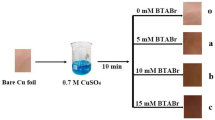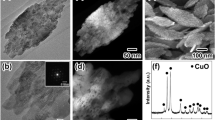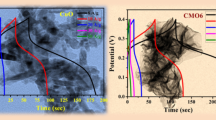Abstract
For the first time, cotton fiber-shaped Cu2O nanoparticles were prepared onto the surface of a commercial copper (Cu) foil via a very simple immersion method at room temperature in which the soaking solution only contained CuSO4, Na2S2O3, and a very little amount of 1-butyl-3-methylimidazolium trifluoroacetate. In this work, the current collectors prepared using 1 mM, 2 mM, and 3 mM Na2S2O3 were, respectively, nominated as current collectors a, b, and c. Interestingly, a cotton fiber-shaped spatial network structure assembled by a large number of 10-nm-sized nanoparticles was presented on the surface of current collector b. The initial discharge capacity (DC) at 0.1 A g−1 of electrode b, namely, the graphite electrode assembled using current collector b, was as high as 467 mAh g−1, almost 1.65 times larger than that of the conventional graphite electrode. Particularly, at 0.5 A g−1 after 10 cycles, the DC value of electrode b (105 mAh g−1) was still about 1.8 times higher than that of the conventional graphite electrode (59 mAh g−1). An immersion method for preparing Cu2O-modified Cu foil at room temperature is developed in this work, which is very meaningful to the development of the Cu foil-based commercial graphite electrode, since no additional energy consumptions and no variations of the electrode preparation process are required.
Graphic abstract








Similar content being viewed by others
References
Gao S, Wang N, Li S, Li D, Cui Z, Yue G, Liu J, Zhao X, Jiang L, Zhao Y (2020) A multi-wall Sn/SnO2@Carbon hollow nanofiber anode material for high-rate and long-life lithium-ion batteries. Angew Chem Int Ed 59:2465–2472
Gao R, Tang J, Yu X, Tang S, Ozawa K, Sasaki T, Qin L-C (2020) In situ synthesis of MOF-derived carbon shells for silicon anode with improved lithium-ion storage. Nano Energy 70:104444
Gao C, Jiang Z, Wang P, Jensen LR, Zhang Y, Yue Y (2020) Optimized assembling of MOF/SnO2/graphene leads to superior anode for lithium ion batteries. Nano Energy 74:104868
Wang K, Wan J, Xiang Y, Zhu J, Leng Q, Wang M, Xu L, Yang Y (2020) Recent advances and historical developments of high voltage lithium cobalt oxide materials for rechargeable Li-ion batteries. J Power Sources 460:228062
Lee SH, Huang C, Grant PS (2019) Layer-by-layer printing of multi-layered heterostructures using Li4Ti5O12 and Si for high power Li-ion storage. Nano Energy 61:96–103
Wang Z, Zhang X, Liu X, Wang Y, Zhang Y, Li Y, Zhao W, Qin C, Mukanova A, Bakenov Z (2020) Bimodal nanoporous NiO@Ni-Si network prepared by dealloying method for stable Li-ion storage. J Power Sources 449:227550
Miankushki HN, Sedghi A, Baghshahi S (2018) Comparison of copper compounds on copper foil as current collector for fabrication of graphene/polypyrrole electrode. J Energy Storage 19:201–212
Cui S, Zhai P, Yang W, Wei Y, Xiao J, Deng L, Gong Y (2020) Large-scale modification of commercial copper foil with lithiophilic metal layer for Li metal battery. Small 16:1905620
Lv J, Kong C, Xu Y, Yang Z, Zhang X, Yang S, Meng G, Bi J, Li J, Yang S (2017) Facile synthesis of novel CuO/Cu2O nanosheets on copper foil for high sensitive nonenzymatic glucose biosensor. Sensors Actuators B 248:630–638
Yuan S, Huang X-L, Ma D-L, Wang H-G, Meng F-Z, Zhang X-B (2014) Engraving copper foil to give large-scale binder-free porous CuO arrays for a high-performance sodium-ion battery anode. Adv Mater 26:2273–2279
Cho I, Gong S, Song D, Lee Y-G, Ryou M-H, Lee YM (2016) Mussel-inspired polydopamine-treated copper foil as a current collector for high-performance silicon anodes. Sci Rep 6:30945
Pi P, Hou K, Zhou C, Li G, Wen X, Xu S, Cheng J, Wang S (2017) Superhydrophobic Cu2S@Cu2O film on copper surface fabricated by a facile chemical bath deposition method and its application in oil-water separation. Appl Surf Sci 396:566–573
Lupan O, Ababii N, Mishra AK, Gronenberg O, Vahl A, Schürmann U, Duppel V, Krüger H, Chow L, Kienle L, Faupel F, Adelung R, de Leeuw NH, Hansen S (2020) Single CuO/Cu2O/Cu microwire covered by a nanowire network as a gas sensor for the detection of battery hazards. ACS Appl Mater Interfaces 12:42248–42263
Panzeri G, Cristina M, Jagadeesh MS, Bussetti G, Magagnin L (2020) Modification of large area Cu2O/CuO photocathode with CuS non-noble catalyst for improved photocurrent and stability. Sci Rep 10:18730
Zhang Z, Sun L, Wu Z, Liu Y, Li S (2020) Facile hydrothermal synthesis of CuO-Cu2O/GO nanocomposites for the photocatalytic degradation of organic dye and tetracycline pollutants. New J Chem 44:6420–6427
Kim E-S, Kim M-C, Moon S-H, Shin Y-K, Lee J-E, Choi S, Park K-W (2019) Surface modified and size-controlled octahedral Cu2O nanostructured electrodes for lithium-ion batteries. J Alloys Compd 794:84–93
Luo Z, Fu L, Zhu J, Yang W, Li D, Zhou L (2020) Cu2O as a promising cathode with high specific capacity for thermal battery. J Power Sources 448:227569
Ding K, Zhao Y, Liu L, Li Y, Liu L, Wang L, He X, Guo Z (2015) Significant role of “burned” graphene in determining the morphology of LiNiO2 prepared under the air conditions. Electrochim Acta 176:240–248
Bhujbal AV, Raut AB, Bhanage BM (2020) Water-assisted electrochemical fabrication of Cu/Cu2O nanoparticles in protic ionic liquid and their catalytic activity in the synthesis of quinazolinones. React Kinet Mech Catal 131:905–918
Wang Y, Cao L, Li J, Kou L, Huang J, Feng Y, Chen S (2020) Cu/Cu2O@Ppy nanowires as a long-life and high-capacity anode for lithium ion battery. Chem Eng J 391:123597
Xu J, Wang X, Yuan N, Hu B, Ding J, Ge S (2019) Graphite-based lithium ion battery with ultrafast charging and discharging and excellent low temperature performance. J Power Sources 430:74–79
Ding K, Han J, Gao X, Wang L, Zhou L, Qu R, He X (2020) An ionic liquid-present hydrothermal method for preparing hawthorn sherry ball shaped palladium (Pd)-based composite catalysts for ethanol oxidation reaction (EOR). Int J Hydrogen Energy 45:1930–1939
Ding K, Okajima T, Ohsaka T (2007) Accelerated electron-transfer reaction of the O2/O2- redox couple on multi-walled carbon nanotubes-modified edge-plane pyrolytic graphite electrode in room-temperature ionic liquids. Electrochemistry 75:35–38
Ding K, Li C, Zhang Y, Wang L, Wei B, Shi X, He X (2018) Using PdO and PbO as the starting materials to prepare a multi-walled carbon nanotubes supported composite catalyst (PdxPby/MWCNTs) for ethanol oxidation reaction (EOR). Int J Hydrogen Energy 43:1523–1528
Ding K, Han J, Gao X, Zhou L, Qu R (2019) Preparation of tin oxide particles using tin-contained organic substance of dioctyltin oxide as the starting material by a calcination method. Mater Chem Phys 232:354–361
Ding K, Zhou L, Qu R, Zhang D, Chen J, He X, Wang L, Wang H, Dou H (2020) Honeycomb-shaped carbon particles prepared from bicycle waste tires for anodes in lithium ion batteries. Mater Chem Phys 251:123202
Ma Z, Zhuang Y, Deng Y, Song X, Zuo X, Xiao X, Nan J (2018) From spent graphite to amorphous sp2 + sp3 carbon-coated sp2 graphite for high-performance lithium ion batteries. J Power Sources 376:91–99
Krajewski M, Michalska M, Hamankiewicz B, Ziolkowska D, Korona KP, Jasinski JB, Kaminska M, Lipinska L, Czerwinski A (2014) Li4Ti5O12 modified with Ag nanoparticles as an advanced anode material in lithium-ion batteries. J Power Sources 245:764–771
Ding K, Zhao J, Sun Y, Chen Y, Wei B, Zhang Y, Pan J (2016) Using potassium ferricyanide as a dopant to prepare K and Fe co-doped Li4Ti5O12. Ceram Int 42:19187–19194
Ding K, Wei B, Zhang Y, Li C, Shi X, Pan J (2017) High performance of Pb-doped Li4Ti5O12 as an anode material for lithium ion batteries. Int J Electrochem Sci 12:8381–8398
Acknowledgements
This work was supported by the Ministry of Science and Technology of China (No. 2019YFE0100200 and 2019YFA0705703), the National Natural Science Foundation of China (No. U1564205), and Research on the Evaluation of Battery Thermal Safety for New Energy Passenger Vehicle (Grant No. 2019ZZ13), and the Technical Innovation Advanced Research Foundation of Hebei Normal University (Grant No. L2018K03).
Author information
Authors and Affiliations
Corresponding authors
Additional information
Publisher's Note
Springer Nature remains neutral with regard to jurisdictional claims in published maps and institutional affiliations.
Rights and permissions
About this article
Cite this article
Ding, K., Zhang, D., Jiang, L. et al. An ionic liquid-present immersion method for preparing cotton fiber-shaped Cu2O nanoparticles at room temperature. J Appl Electrochem 52, 55–65 (2022). https://doi.org/10.1007/s10800-021-01614-5
Received:
Accepted:
Published:
Issue Date:
DOI: https://doi.org/10.1007/s10800-021-01614-5




